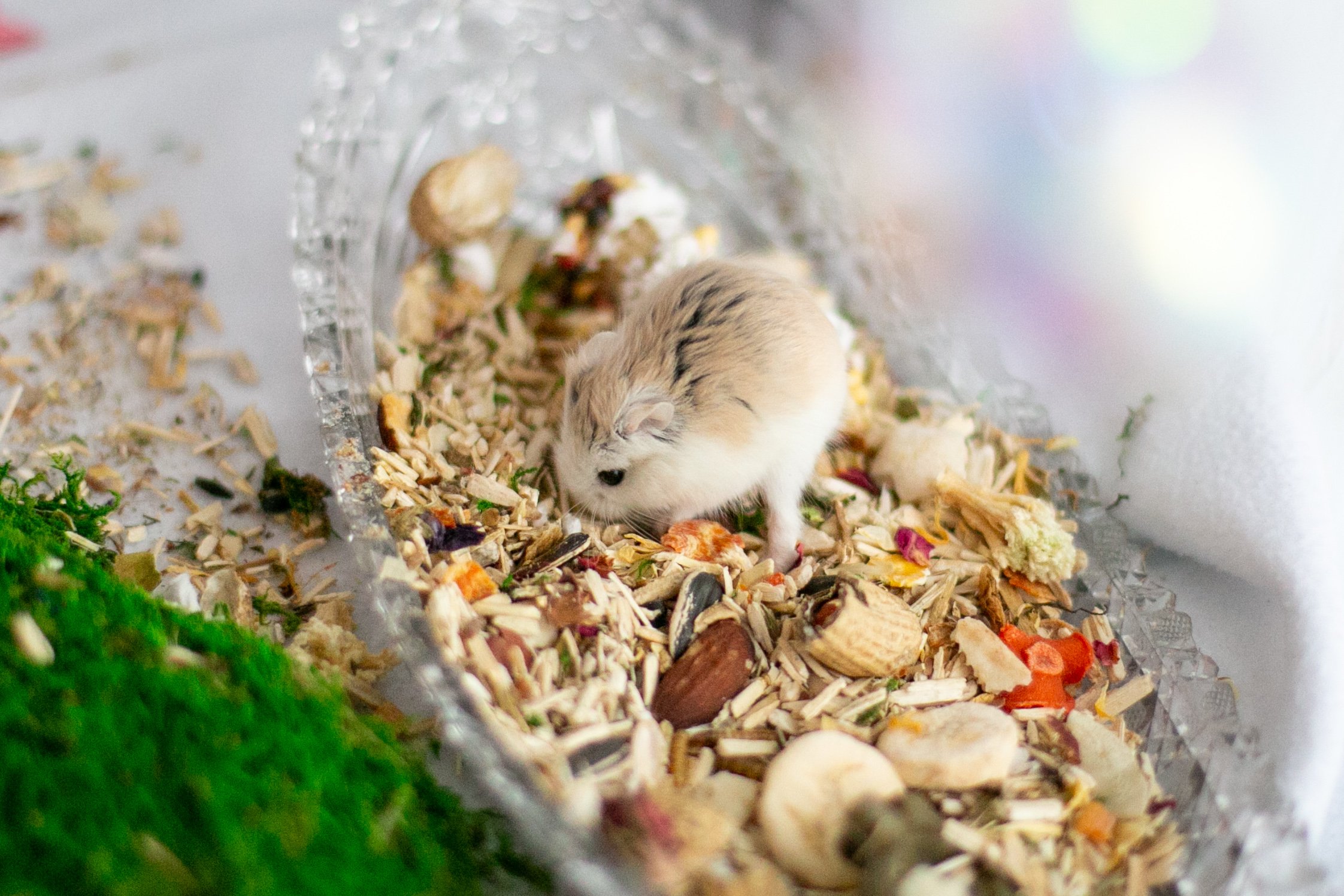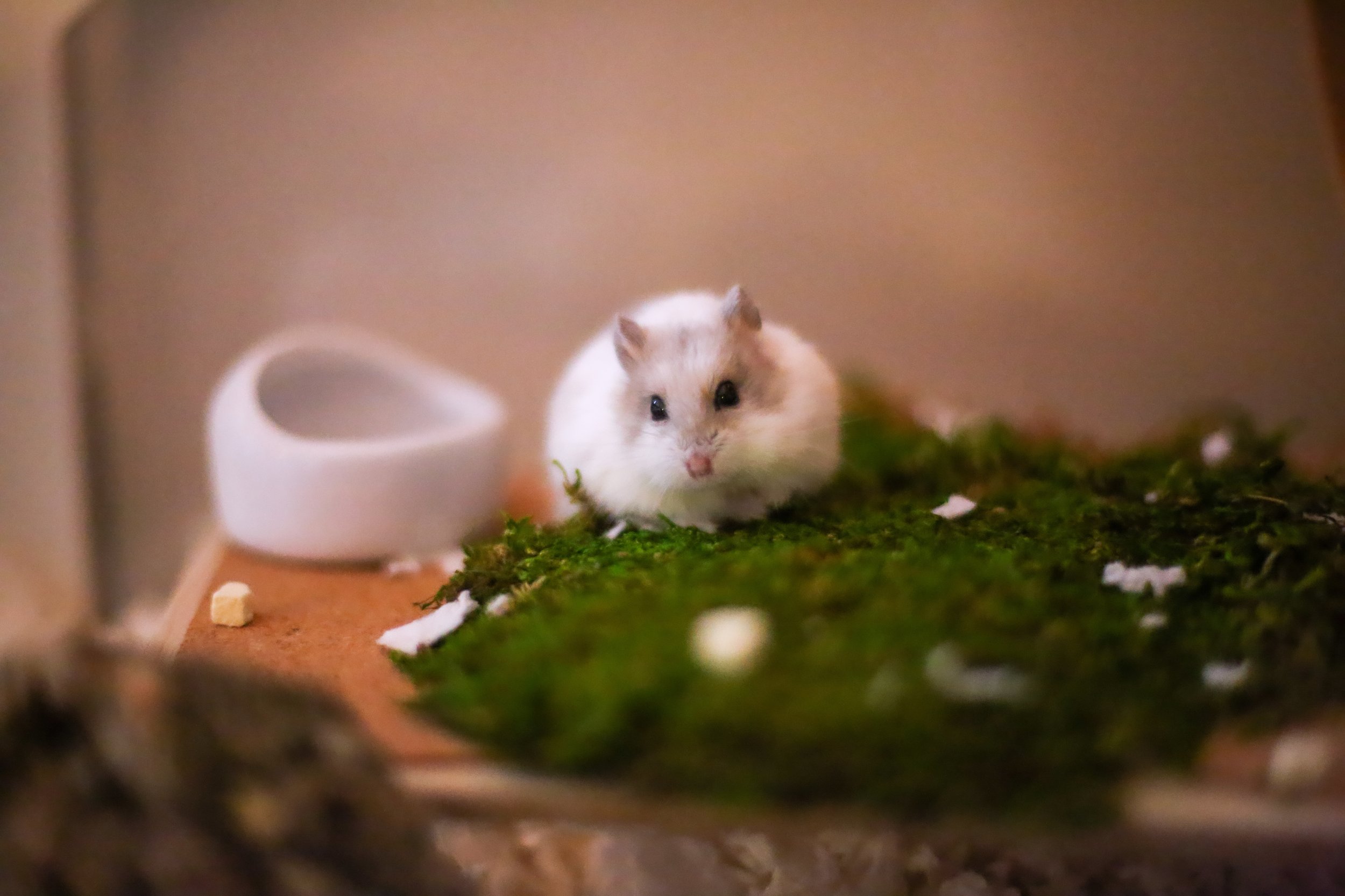Hamster Bedding / Substrates
Stan the Robo enjoys the fluffy, white Clean and Cozy unscented paper bedding from Kaytee. Underneath the paper bedding you can see a layer of Eaton hemp bedding. I use both in my enclosures regularly.
The bedding or substrates you use for your hamster may vary depending on where you live and what’s available to you! Since I live in the US, I will be recommending products that are available here.
Before I use any bedding in my hamster’s cages I freeze it for 48 hours. While there may be some extraordinary bugs that can survive these temps, for the most part, freezing should eliminate most pests that might be found in hamster bedding. I highly recommend doing this as cleaning an infested hamster cage can be costly and time consuming!
Paper Bedding
Paper bedding is the most important type of bedding you will give to your hamster- this is because it’s the only bedding available in the US that supports burrowing. While other types of safe beddings and substrates exist, none of them allow your hamster to create a system of tunnels, which is a huge part of what they do! If you can only afford one bedding right now, start with a good paper bedding.
Stick with unscented bedding - hamsters have delicate little respiratory settings that can get irritated by scents. I prefer Kaytee Clean and Cozy or Small Pet Select. Many people also use Carefresh, although Carefresh doesn’t hold burrows as well as the other two options.
I prefer white bedding, since it is easier to keep clean (you can see the tiny poops and urine easily). Other people like the natural colored paper bedding, and some others like colored bedding. Any of those options are fine, just make sure it is unscented- hamsters have very sensitive noses and delicate respiratory systems, additional scents are not good for their health or happiness.
Aspen & Other Textures
Some people use aspen wood shavings in their enclosure. I love aspen- it smells wonderful and looks nice! I have a lot of seasonal allergies so I wear a mask when I handle aspen. Aspen is not as soft as paper bedding and does not hold burrows. Some people mix aspen in with their paper bedding, although I find my hamsters seem to prefer just paper bedding for their nest.
You can also use aspen in a part of your hamster’s enclosure away from their nesting area, for instance, around a wheel or sand bath.
I personally have moved away from using aspen - my hamsters seem to not like it much, and it bothers my allergies.
Hemp
Hemp is one of my favorite substrates, I use it in all of my hamster enclosures! Please note- hemp does not hold burrows and is not a replacement for paper bedding. However, it is a great alternative texture. It’s soft (and not splintery) and is great for sprinkling seeds & flowers in for a foraging opportunity.
Hemp is also very eco friendly - it can grow almost anywhere and takes very little water or pesticides.
Please see my Setting Up a Hamster Cage page for how I use it!
Miles the Robo shows off his long legs in a hemp - foraging area in the playpen
Loose Coconut Fiber
One of my favorite digging substances is loose coconut fiber! Sprinkle some millet & hamster flowers and let your hamsters go crazy! Coconut fiber is sort of like a light weight dirt. Until you feel it, it’s a bit hard to describe!
I use coconut fiber in large pans or Pyrex containers in my hamster’s enclosure and let my hamsters dig around in them. I also set up digging areas in their playpens. They love it!
Timothy Hay
Timothy hay isn’t generally recommended for hamsters due to it’s very sharp & hard nature. Timothy hay can be a potential hazard to hamster’s eyes if they try to burrow in it.
All hays come in 1st, 2nd & 3rd cuttings. 1st cuttings tend to be coarser while 2nd and 3rd cuttings are softer. Even so, I would not recommend timothy hay for your hamsters, I just don’t think it’s necessary or worth the risk. For more on hay types, check out Small Pet Select.
Orchard Grass Hay
Orchard grass hay is generally used in hamster cages as a layer between layers of paper bedding. Some people say this helps add stability to the hamster burrows in addition to looking very beautiful! Here is a great example of someone using hay as a layer in their paper bedding.
Personally I have found my dwarf hamsters are scared of the texture and seem not to like it. It also bothered my allergies, so I no longer use it.
Niteangel now makes a blend of orchard grass & other botanicals meant to be an enriching texture for your hamsters. I personally haven’t tried it yet, but Niteangel products are always good quality and worth a try!
Moss
Moss is a great addition to your hamster’s cage! It can help with landscaping and provide a nice, cozy spot for your hamster to hang out on.
I use the moss from Galapagos brand and love it. Niteangel has recently come out with a moss that looks very nice too!
“Sheet Moss” comes in large pieces, while “sphagnum moss” or “forest moss” is loose and better for scattering or crafting with.
My hamsters sniff and nibble at the moss when they first see it, but it must taste very bitter because I’ve never seen them nibble at it again.
Please ensure you get the moss for reptiles as moss made for floral arrangements may have additional dyes that are not healthy for hamsters.
Peggy the Robo models how loose sphagnum moss can be placed around a sand bath in the hamster playpen
Little Maurice enjoys the softness of the sheet moss in his Niteangel Vista size L
*This website includes affiliate links- as an Amazon Associate I earn from qualifying purchases.
















